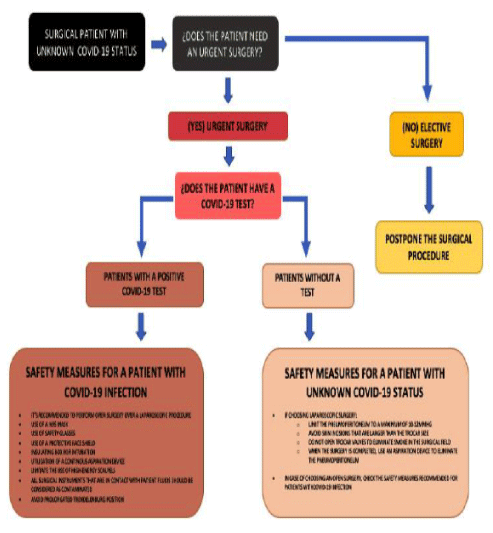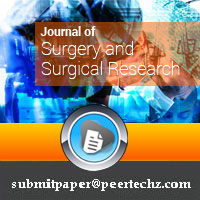Journal of Surgery and Surgical Research
Surgery on patients with suspected or confirmed COVID-19. Management and treatment recommendations
Díaz-Girón Gidi A1*, Reyes-Rodríguez E2, Montalvo-Domínguez G2 and Correa- Rovelo JM3
2Third year General Surgery Resident, Hospital Médica Sur, México
3Professor of General Surge, Acad. D.I.M. PHD Operations Department, General Hospital of Mexico, Mexico
Cite this as
Díaz-Girón Gidi A, Reyes-Rodríguez E, Montalvo-Domínguez G, Correa- Rovelo JM (2020) Surgery on patients with suspected or confirmed COVID-19. Management and treatment recommendations. J Surg Surgical Res 6(2): 123-125. DOI: 10.17352/2455-2968.000111Current crisis due to new coronavirus SARS-CoV-2 pandemic, puts medical and paramedical personnel working in surgical areas at risk. Despite the fact that this pandemic has left many questions about which would be the ideal behaviors in this situation, due to the speed of spread, lack of experience and, reliable randomized or double-blind protocols; It is necessary to elaborate and apply an algorithm based on experience, common sense and references, on how to safely manage suspected or confirmed COVID-19 surgical patients, establishing and fulfilling goals and recommendations in order to reduce infection spreading, and protect health care providers and patients. In the present study, surgical management for potentially infected patients recommendations are established.
Introduction
New coronavirus SARS-CoV-2 (COVID-19) was identified in early December in Wuhan, China [1]. on January 20, 2020, the first case in the US was notified [2].
Disease transmission was in exponential magnitude, reporting 332,930 confirmed cases worldwide and 14,510 deaths on March 23, 2020 due to the new virus [3].
By July 12, 2020, there have been reported 12,945,505 confirmed cases of COVID-19 and 571,444 deaths worldwide. With an overall fatality rate of 7 %. During the last 14 days, the number of new reported cases represents 76% of the total cumulative cases [4,5].
The first registered case in Mexico was reported on February 28, 2020, related to a 35-year-old male with a travel history to Italy. Declaring a Health Emergency on March 30, 2020. Currently (July 13, 2020), 299,750 confirmed cases and 35,006 deaths caused by COVID-19 have been reported in our Country [6].
In anticipation of the expected COVID-19 infected patients increase and the need to rationally use Personal Protective Equipment (PPE) while continuing to provide surgical procedures, we developed institutional guidelines, for surgical team members precaution during COVID-19 pandemic. Although the majority of the evidence suggests that COVID-19 spreads through droplets, some literature supports aerosols propagation [7,8]. Among infectious diseases experts from our institution, we developed our guidelines based on potential spreading patterns, exposure risk and PPE conservation.
The Infectious Disease Control and Prevention Center recently submitted recommendations, which were updated by the American College of Surgeons. Both organizations recommend stopping elective surgery and taking general precautions [9].
Recent experience in Shanghai and Milan share the following recommendations. Prevention and management of aerosol dispersion. Keep the surgical equipment clean of body fluids at all times throughout the surgical procedure. Use of suction equipments to aspirate pneumoperitoneum before shifting from laparoscopic surgery to open surgery. Keeping pneumoperitoneum pressure as low as it is possible, without sacrificing visibility during the surgical procedure. Reduce as much as possible the time the patient spends in Trendelenburg position. Decrease the time of high-energy devices use, performing adequate hemostasis despite the limitation of such devices [10].
The Society of American Gastrointestinal and Endoscopic Surgeons (SAGES) recommends to defer elective surgeries in case the surgery is not an emergency, to first opt for an open surgery, in case a laparoscopic surgery is performed an air extraction system should be used at all times during the procedure [11].
Methods
The hospital's surgical team decided to implement recommendations, as well as develop a common algorithm to identify suspected or confirmed COVID-19 cases in order to use PPE appropriately, which would be used in all surgical procedures. This work team was constituted by the titular professor of the General Surgery specialty, General Surgery residents and attending surgeons.
The objective was to identify surgical patients with suspected or confirmed COVID-19, who require abdominal surgery, to implement an internal hospital action strategy in order to ensure the safety of patients when facing potential risk of infection, and dissemination coming from suspected or confirmed asymptomatic carriers, to put into practice the guidelines created by the work team along international recommendations, and to implement those guidelines in all surgical procedures.
Prior to working on the algorithm, current data describing COVID-19 transmission inside and outside hospital facilities were reviewed. The draft algorithm was reviewed by Infection and Infectious Disease Control experts, and was approved by the hospital's epidemiological surveillance committee in order to ensure the accuracy and compliance of the improved institutional practices.
Results
A flow diagram algorithm was created (Figure 1). We relied on the assumption that every patient could be a COVID-19 infected patient until proven otherwise. This assumption is based on the growing community transmission of COVID-19.
Patients who do not meet the criteria for COVID-19 testing (Table 1), may be operated using traditional techniques, taking standard safety measures.
In patients who meet the criteria for COVID-19 testing, the procedure will be postponed until the testing results are known. Those patients requiring urgent procedures, will be categorized into two categories, patients with confirmatory COVID-19 test and patients without test. In patients with confirmed COVID-19, urgent surgical procedures will be performed following the safety recommendations for SARS-CoV-2 patients (Table 2); such as using N95 respirators, surgical face shields and opting for open surgery techniques. Patients with negative COVID-19 testing results may be operated using traditional techniques.
Patients who do not meet the criteria for COVID-19 testing (Table 1), may be operated using traditional techniques, taking standard safety measures.
In patients who meet the criteria for COVID-19 testing, the procedure will be postponed until the testing results are known. Those patients requiring urgent procedures, will be categorized into two categories, patients with confirmatory COVID-19 test and patients without test. In patients with confirmed COVID-19, urgent surgical procedures will be performed following the safety recommendations for SARS-CoV-2 patients (Table 2); such as using N95 respirators, surgical face shields and opting for open surgery techniques. Patients with negative COVID-19 testing results may be operated using traditional techniques.
+ Consider those instruments in contact with body fluids contaminated.
In patients who require emergency procedures but have not been tested for COVID-19, the safety measures for probable SARS-CoV-2 infected patients should be taken (Table 3).
Rapid testing for COVID-19 virus will not be possible in case of emergency procedures. We assumed that all patients undergoing emergency procedures were infected with COVID-19 until proven otherwise, the use of PPE for the entire surgical team is required.
Conclusions
The current COVID-19 pandemic has required the prompt development of new hospital guidelines for clinical facilities. Although COVID-19 is a new threat, we have shown that by developing an easy-to-follow algorithm for surgical and intervention teams, we can guarantee optimal safety for health care providers. This algorithm prioritizes patients according to disease severity, tests results and symptomatology, while ensuring rational use of PPE in limited resources environments.
- Huang C, Wang Y, Li X, Ren L, Zhao J, et al. (2020) Clinical features of patients infected with 2019 novel coronavirus in Wuhan, China. Lancet 395: 497-506. Link: https://bit.ly/3f9VSI8
- Holshue ML, DeBolt C, Lindquist S, Lofy KH, Wiesman J, et al. (2020) First case of 2019 novel coronavirus in the United States. N Engl J Med 382: 929-936. Link: https://bit.ly/3fgYkgp
- Lipsitch M, Swerdlow DL, Finelli L (2020) Defining The Epidemiology Of Covid-19 - Studies Needed. NEJM 382: 1194-1196. Link: https://bit.ly/330GYBT
- McMichael TM, Currie DW, Clark S, Pogosjans S, Kay M, et al. (2020) Epidemiology Of Covid-19 In A Long-Term Care Facility In King County, Washington. NEJM 382: 2005-2011. Link: https://bit.ly/3f9Kso7
- World Health Organization. Coronavirus disease (COVID-2019) situation reports. Link: https://bit.ly/3hM7sei
- Gob MX (2020) Comunicado Técnico Diario Nuevo Coronavirus En El Mundo (COVID-19).
- van Doremalen N, Bushmaker T, Morris DH, Holbrook MG, Gamble A et al. (2020) Aerosol and surface stability of SARS-CoV-2 as compared with SARS-CoV-1. N Engl J Med 382: 1564-1567. Link: https://bit.ly/2EkOxZF
- Guan W-j, Ni ZY, Hu Y Liang WH, Ou CQ, et al. (2020) Clinical characteristics of coronavirus disease 2019 in China. N Engl J Med 382: 1708-1720. Link: https://bit.ly/309VsgR
- American College of Surgeons (2020) Create A Surgical Review Committee For COVID-19-Related Surgical Triage Decision Making. Link: https://bit.ly/335FMgj
- Zheng MH, Boni L, Fingerhut A (2020) Minimally Invasive Surgery and the Novel Coronavirus Outbreak: Lessons Learned in China and Italy. Ann Surg. Link: https://bit.ly/3ga230p
- Pryor A (2020) SAGES and EAES Recommendations Regarding Surgical Response To COVID-19 Crisis. Link: https://bit.ly/2D0K3Hg
Article Alerts
Subscribe to our articles alerts and stay tuned.
 This work is licensed under a Creative Commons Attribution 4.0 International License.
This work is licensed under a Creative Commons Attribution 4.0 International License.


 Save to Mendeley
Save to Mendeley
